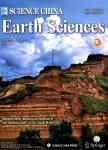Transport network and flow mechanism of shallow ore-bearing magma in Tongling ore cluster area
Transport network and flow mechanism of shallow ore-bearing magma in Tongling ore cluster area作者机构:State Key Laboratory of Geological Processes and Mineral Resources China University of Geosciences Beijing China Key Laboratory of Lithosphere Tectonics and Lithoprobing Technology of Ministry of Education China University of Geosciences Beijing China Faculty of Earth Sciences China University of Geosciences Wuhan China School of Mathematics and Information Science Guangzhou University Guangzhou China
出 版 物:《Science China Earth Sciences》 (中国科学(地球科学英文版))
年 卷 期:2006年第49卷第4期
页 面:397-407页
核心收录:
学科分类:081803[工学-地质工程] 08[工学] 0708[理学-地球物理学] 0818[工学-地质资源与地质工程] 0704[理学-天文学]
基 金:the National Natural Science Foundation of China(Grant No.40234051) the Fostering Plan Fund for Beyond-Cen-tury Excellent Talent of the Ministry of Education the Science and Technology Key Item of the Ministry of Education(Grant No.03678) the Special Plan of Science and Technology of the Ministry of Land and Resources(Grant No.20010103)
主 题:Tongling, structural network, magma intrusion, fractal, dyke.
摘 要:Abundant studies revealed that shallow intrusions of the Yanshanian epoch resulted in the mass mineralization of the Tongling region. Various evidences showed there existed a concealed magma chamber at ?10 km depth in the middle part of this region during Yanshanian epoch, from which the ore-forming magma was generated and then transported to the superficial layer. Yet the transport network and flow mechanism of the shallow ore-bearing magma, the key problem associ- ated with ore-forming process, was relatively little focused on. Integrate analysis of structural me- chanics, statistical fractal and geological facts suggested that NE trending high-angle fold-related thrust faults and the tessellated basement ones served as the main pathways for the shallow magma’s transporting, moreover, the saddle void spaces among adjacent strata in the folds upon this fault system provided the place for magma’s emplacement. So the folds in the upper part and faults in the lower part of the upper crust constituted the fluid’s transport and emplacement network. During the deformation of geologic body with multi-layer structure, the layers in the upper part tended to fold when received the jacking stress from the lower part, while the lower one inclined to fault undergoing loads of the upper part. And the producing probability of this structure assemblage was highly in- creased in the condition, such as in the Tongling area, that the mechanic rigidity of the lower layers was stronger than that of the upper ones. For the pre-existence of fluid-conducting network, the top magma with high volatile in the magma chamber transported rapidly to the superficial layer in dyking pattern, located in the void spaces of folds, filled and reconstructed them. The sudden drop of pres- sure caused the fluid unmixing from the magma and mass ore-forming elements concentration. Pulse activity of the dyking may be the principal reason why magmatic bodies in the Tongling area were spatially-temporally con



